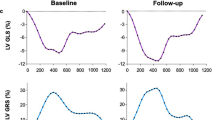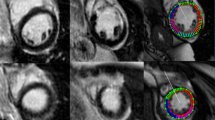Abstract
Objectives
To investigate whether subendocardial and transmural myocardial infarction can be identified and differentiated using the peak circumferential and longitudinal strains measured by fast strain-encoded (SENC).
Methods
Nineteen patients with ischemic heart diseases underwent imaging with fast SENC and late gadolinium enhancement (LGE) MRI at 3 T. Fast SENC measurements were performed in three short-axis slices (basal, mid-ventricular and apical levels) and one long-axis view (four-chamber) to assess peak longitudinal and circumferential systolic strains.
Results
All patients showed myocardial infarction with an average of 7 positive LGE segments. A total of 304 segments for longitudinal strains (LS) and 114 segments for circumferential strains (CS) could be analysed. Positive LGE segments showed lower peak CS and LS compared with the no LGE segments (P < 0.0001 for both). Segments with subendocardial infarction showed reduced CS and LS compared with the no LGE segments (P < 0.0001 for both). There was a significant difference in CS between subendocardial and transmural infarct segments (P = 0.03), but no significant difference in LS between them (P = 0.64).
Conclusions
Fast SENC can identify old myocardial infarction and differentiate subendocardial from transmural infarction.








Similar content being viewed by others
References
Greenbaum RA, Ho SY, Gibson DG, Becker AE, Anderson R (1981) Left ventricular fibre architecture in man. Br Heart J 45:248–263
Torrent-Guasp F, Buckberg GD, Clemente C, Cox JL, Coghlan HC, Gharib M (2001) The structure and function of the helical heart and its buttress wrapping. I. The normal macroscopic structure of the heart. Semin Thorac Cardiovasc Surg 13:301–319
Waldman LK, Fung YC, Covell JW (1985) Transmural myocardial deformation in the canine left ventricle. Normal in vivo three-dimensional finite strains. Circ Res 57:152–163
Thanavaro S, Krone RJ, Kleiger RE, Province MA, Miller JP, deMello VR, Oliver GC (1980) In-hospital prognosis of patients with first nontransmural and transmural infarctions. Circulation 61:29–33
Kim RJ, Hillenbrand HB, Judd RM (2000) Evaluation of myocardial viability by MRI. Herz 25:417–430
Kim RJ, Wu E, Rafael A, Chen EL, Parker MA, Simonetti O, Klocke FJ, Bonow RO, Judd RM (2000) The use of contrast-enhanced magnetic resonance imaging to identify reversible myocardial dysfunction. N Engl J Med 343:1445–1453
Fieno DS, Kim RJ, Chen EL, Lomasney JW, Klocke FJ, Judd RM (2000) Contrast-enhanced magnetic resonance imaging of myocardium at risk: distinction between reversible and irreversible injury throughout infarct healing. J Am Coll Cardiol 36:1985–1991
Kim RJ, Fieno DS, Parrish TB, Harris K, Chen EL, Simonetti O, Bundy J, Finn JP, Klocke FJ, Judd RM (1999) Relationship of MRI delayed contrast enhancement to irreversible injury, infarct age, and contractile function. Circulation 100:1992–2002
Shan K, Constantine G, Sivananthan M, Flamm SD (2004) Role of cardiac magnetic resonance imaging in the assessment of myocardial viability. Circulation 109:1328–1334
Kuo PH (2008) Gadolinium-containing MRI contrast agents: important variations on a theme for NSF. J Am Coll Radiol 5:29–35
Thomsen HS (2007) ESUR guideline: gadolinium-based contrast media and nephrogenic systemic fibrosis. Eur Radiol 17:2692–2696
Garot J, Lima JA, Gerber BL, Sampath S, Wu KC, Bluemke DA, Prince JL, Osman NF (2004) Spatially resolved imaging of myocardial function with strain-encoded MR: comparison with delayed contrast-enhanced MR imaging after myocardial infarction. Radiology 233:596–602
Neizel M, Lossnitzer D, Korosoglou G, Schaufele T, Lewien A, Steen H, Katus HA, Osman NF, Giannitsis E (2009) Strain-encoded Magnetic Resonance Imaging to evaluate regional heterogeneity of myocardial strain in healthy volunteers: comparison with conventional tagging. J Magn Reson Imaging 29:99–105
Osman NF, Sampath S, Atalar E, Prince JL (2001) Imaging longitudinal cardiac strain on short-axis images using strain-encoded MRI. Magn Reson Med 46:324–334
Pan L, Stuber M, Kraitchman DL, Fritzges DL, Gilson WD, Osman NF (2006) Real-time imaging of regional myocardial function using fast-SENC. Magn Reson Med 55:386–395
Korosoglou G, Youssef AA, Bilchick KC, Ibrahim ES, Lardo AC, Lai S, Osman NF (2008) Real-time fast strain-encoded magnetic resonance imaging to evaluate regional myocardial function at 3.0 Tesla: comparison to conventional tagging. J Magn Reson Imaging 27:1012–1018
Chan J, Hanekom L, Wong C, Leano R, Cho GY, Marwick TH (2006) Differentiation of subendocardial and transmural infarction using two-dimensional strain rate imaging to assess short-axis and long-axis myocardial function. J Am Coll Cardiol 48:2026–2033
Moore CC, Lugo-Olivieri CH, McVeigh ER, Zerhouni EA (2000) Three-dimensional systolic strain patterns in the normal human left ventricle: characterization with tagged MR imaging. Radiology 214:453–466
Acknowledgements
This research was presented at the ECR 2010 in Vienna and was awarded the certificate of merit.
Author information
Authors and Affiliations
Corresponding author
Rights and permissions
About this article
Cite this article
Oyama-Manabe, N., Ishimori, N., Sugimori, H. et al. Identification and further differentiation of subendocardial and transmural myocardial infarction by fast strain-encoded (SENC) magnetic resonance imaging at 3.0 Tesla. Eur Radiol 21, 2362–2368 (2011). https://doi.org/10.1007/s00330-011-2177-4
Received:
Revised:
Accepted:
Published:
Issue Date:
DOI: https://doi.org/10.1007/s00330-011-2177-4




